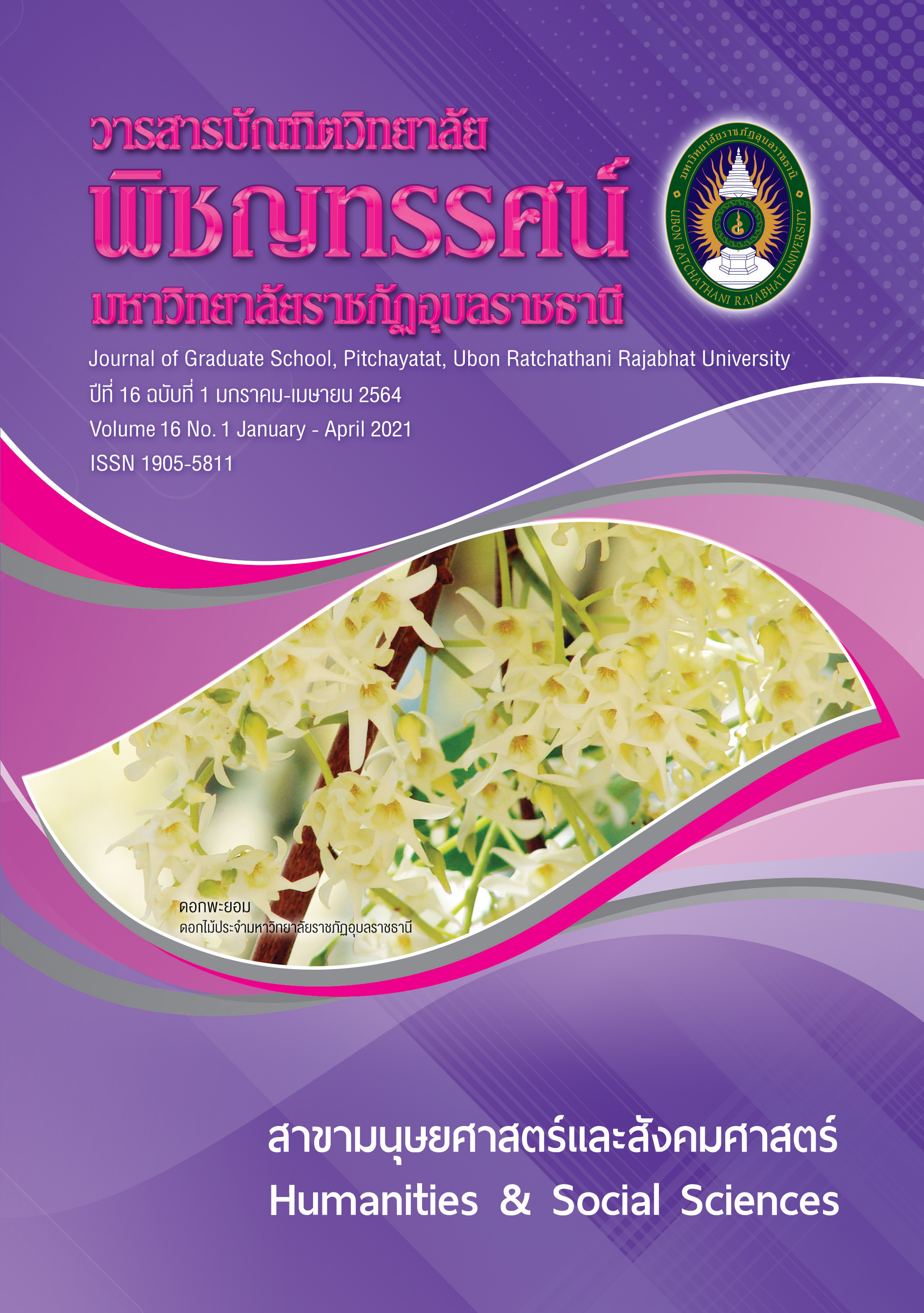การพัฒนารูปแบบการสอนเพื่อส่งเสริมความสามารถในการแก้ปัญหาอย่างสร้างสรรค์ วิชาคณิตศาสตร์ เรื่องฟังก์ชันตรีโกณมิติ ระดับชั้นมัธยมศึกษาปีที่ 5
คำสำคัญ:
รูปแบบการสอนเพื่อส่งเสริมความสามารถในการแก้ปัญหาอย่างสร้างสรรค์บทคัดย่อ
การวิจัยนี้มีวัตถุประสงค์เพื่อ 1) ศึกษาข้อมูลพื้นฐานในการพัฒนารูปแบบการสอน เพื่อส่งเสริมความสามารถในการแก้ปัญหาอย่างสร้างสรรค์ วิชาคณิตศาสตร์ เรื่อง ฟังก์ชันตรีโกณมิติ ระดับชั้นมัธยมศึกษาปีที่ 5 2) พัฒนารูปแบบการสอนเพื่อส่งเสริมความสามารถในการแก้ปัญหาอย่างสร้างสรรค์วิชาคณิตศาสตร์ เรื่อง ฟังก์ชันตรีโกณมิติ ระดับชั้นมัธยมศึกษาปีที่ 5 มีประสิทธิภาพตามเกณฑ์ 80/80 3) ทดลองใช้รูปแบบการสอนเพื่อส่งเสริมความสามารถในการแก้ปัญหาอย่างสร้างสรรค์ วิชาคณิตศาสตร์ เรื่อง ฟังก์ชันตรีโกณมิติ ระดับชั้นมัธยมศึกษาปีที่ 5 และ 4) ประเมินประสิทธิภาพของรูปแบบการสอนเพื่อส่งเสริมความสามารถในการแก้ปัญหาอย่างสร้างสรรค์วิชาคณิตศาสตร์ เรื่อง ฟังก์ชันตรีโกณมิติ ระดับชั้นมัธยมศึกษาปีที่ 5 ตัวอย่างที่ใช้ในการวิจัยครั้งนี้เป็นนักเรียนชั้นมัธยมศึกษาปีที่ 5/9 โรงเรียนพิบูลมังสาหาร โดยการสุ่ม แบบกลุ่ม จำนวน 36 คน เครื่องมือที่ใช้ประกอบด้วย รูปแบบการสอนคณิตศาสตร์ แผนการจัดการเรียนรู้ แบบประเมินความสามารถในการแก้ปัญหาอย่างสร้างสรรค์ แบบทดสอบวัดผลสัมฤทธิ์ทางการเรียน แบบประเมินวินัย ในตนเอง แบบประเมินคุณลักษณะจิตอาสา และแบบสอบถามความคิดเห็นของนักเรียนที่มีต่อการใช้รูปแบบการสอน วิเคราะห์ข้อมูลโดยการหาค่าเฉลี่ย ส่วนเบี่ยงเบนมาตรฐาน สถิติ และการวิเคราะห์เนื้อหา
ผลการวิจัยพบว่า
- ผลการศึกษาข้อมูลพื้นฐาน พบว่า นักเรียนมีความสนใจในการจัดการเรียนการสอนด้วยรูปแบบการสอนคณิตศาสตร์เพื่อส่งเสริมความสามารถในการแก้ปัญหาอย่างสร้างสรรค์ วิชาคณิตศาสตร์เรื่องฟังก์ชันตรีโกณมิติ ระดับชั้นมัธยมศึกษาปีที่ 5
- ผลการพัฒนารูปแบบการสอนคณิตศาสตร์เพื่อส่งเสริมความสามารถในการแก้ปัญหาอย่างสร้างสรรค์ วิชาคณิตศาสตร์ เรื่องฟังก์ชันตรีโกณมิติ ระดับชั้นมัธยมศึกษาปีที่ 5 มีกระบวนการเรียนการสอน 7 ขั้นตอน คือ 1) ขั้นสร้างความขัดแย้งทางปัญญา 2) ขั้นวิเคราะห์ปัญหา 3) ขั้นศึกษาหาข้อมูล 4) ขั้นสะท้อนความคิด 5) ขั้นกระตุ้นสมองประลองปัญญา 6) ขั้นตรวจสอบยอมรับ 7) ขั้นขยายองค์ความรู้
- ผลการทดลองใช้รูปแบบการสอนคณิตศาสตร์เพื่อส่งเสริมความสามารถในการแก้ปัญหาอย่างสร้างสรรค์ วิชาคณิตศาสตร์ เรื่องฟังก์ชันตรีโกณมิติ ระดับชั้นมัธยมศึกษาปีที่ 5 มีประสิทธิภาพเท่ากับ 37/82.78
- ผลการประเมินประสิทธิภาพของรูปแบบการสอนเพื่อส่งเสริมความสามารถในการแก้ปัญหาอย่างสร้างสรรค์ วิชาคณิตศาสตร์ เรื่อง ฟังก์ชันตรีโกณมิติ ระดับชั้นมัธยมศึกษาปีที่ 5 พบว่า นักเรียนมีผลสัมฤทธิ์ทางการเรียนคณิตศาสตร์ เรื่อง ฟังก์ชันตรีโกณมิติ หลังเรียนสูงกว่าก่อนเรียนโดยใช้รูปแบบการสอนเพื่อส่งเสริมความสามารถในการแก้ปัญหาอย่างสร้างสรรค์ วิชาคณิตศาสตร์ เรื่อง ฟังก์ชันตรีโกณมิติ ระดับชั้นมัธยมศึกษาปีที่ 5 อย่างมีนัยสำคัญทางสถิติและ นักเรียนมีความสามารถ ในการแก้ปัญหาอย่างสร้างสรรค์วิชาคณิตศาสตร์หลังเรียนสูงกว่าก่อนเรียนอย่างมีนัยสำคัญทางสถิติที่ระดับ .01
- นักเรียนมีวินัยในตนเองหลังเรียนสูงกว่าก่อนเรียน อย่างมีนัยสำคัญทางสถิติ
เอกสารอ้างอิง
กลุ่มสาระการเรียนรู้คณิตศาสตร์. รายงานการประเมินตนเอง (SAR). อุบลราชธานี: โรงเรียนพิบูลมังสาหาร, 2560.
โกวิทย์ พวงงาม. การปกครองท้องถิ่นว่าด้วยทฤษฎี แนวคิด และหลักการ . (เอกสารประกอบคำสอน). กรุงเทพฯ: รัฐประศาสนศาสตรบัณฑิต สาขาการปกครองท้องถิ่น, 2550.
ทดสอบทางการศึกษาแห่งชาติ (องค์การมหาชน), สถาบัน. รายงานผลการทดสอบทางการศึกษาระดับชาติขั้นพื้นฐาน (O-NET) ชั้นมัธยมศึกษาปีที่ 6. (ออนไลน์) 2560. จาก http://www.niets.or.th.
นิพิฐพร โกมลกิติศักดิ์. วิเคราะห์ผลของกระบวนการแก้ปัญหาเชิงสร้างสรรค์ที่มีต่อความสามารถในการแก้ปัญหาเชิงสร้างสรรค์ ทักษะการทำงานกลุ่ม และการเห็นคุณค่าในตนเองของนักเรียน มัธยมศึกษาตอนต้น: การทดลองแบบอนุกรมเวลา. ปริญญาครุศาสตรมหาบัณฑิต จุฬาลงกรณ์มหาวิทยาลัย, 2553.
ปานทอง กุลนาถศิริ. การจัดการศึกษาคณิตศาสตร์ในศตวรรษที่ 21. (ออนไลน์) .2557 (อ้างเมื่อ 4 กุมภาพันธ์ 2557). จาก http://www.ipst.ac.th.
มาเรียม นิลพันธุ์. วิธีวิจัยทางการศึกษา. นครปฐม: ศูนย์วิจัยและพัฒนาทางการศึกษา คณะศึกษาศาสตร์ มหาวิทยาลัยศิลปากร, 2553.
เลขาธิการสภาการศึกษา, สำนักงาน. รายงานการวิจัยเรื่อง การกำหนดแนวทางพัฒนาการศึกษาไทยกับการเตรียมพร้อมสู่ศตวรรษที่ 21. กรุงเทพฯ: สกศ, 2556.
วัชรา เล่าเรียนดี. รูปแบบและกลยุทธ์การจัดการเรียนรู้เพื่อพัฒนาทักษะการคิด. พิมพ์ครั้งที่ 10. นครปฐม: มหาวิทยาลัยศิลปากร, 2556.
วิชาการและมาตรฐานการศึกษา, สำนักงาน. ตัวชี้วัดและสาระการเรียนรู้แกนกลาง กลุ่มสาระการเรียนรู้คณิตศาสตร์ ตามหลักสูตรแกนกลางการศึกษาขั้นพื้นฐาน พุทธศักราช 2551. กรุงเทพฯ: โรงพิมพ์ชุมนุมสหกรณ์การเกษตรแห่งประเทศไทย, 2551.
ศึกษาธิการ, กระทรวง. หลักสูตรแกนกลางการศึกษาขั้นพื้นฐาน พุทธศักราช 2551. กรุงเทพฯ: โรงพิมพ์ชุมนุมสหกรณ์การเกษตรแห่งประเทศไทย, 2552.
ส่งเสริมการสอนวิทยาศาสตร์และเทคโนโลยี, สถาบัน. ทักษะกระบวนการทางคณิตศาสตร์. พิมพ์ครั้งที่ 3 .กรุงเทพฯ: 3-คิว มีเดีย, 2555.
สาโรช บัวศรี. จริยธรรมศึกษา. กรุงเทพฯ: คุรุสภาลาดพร้าว, 2526.
อรวรรณ ตันสุวรรณรัตน์. ผลของการจัดกิจกรรมการเรียนรู้คณิตศาสตร์โดยใช้กระบวนการแก้ปัญหาเชิงสร้างสรรค์ที่มีต่อความสามารถในการแก้ปัญหาและความคิดสร้างสรรค์ทางคณิตศาสตร์ของนักเรียนมัธยมศึกษาปีที่ 2. ปริญญาครุศาสตรมหาบัณฑิต จุฬาลงกรณ์มหาวิทยาลัย, 2552.
Dick, W., L Carey. and J. O. Carey, The Systematic Design of Instruction. 5th ed. New York: Addison – Wesley, Longman, 2005.
Joyce, B., M Weil and E. Calhoun. Models of Teaching. 8th ed. New York: Allyn & Bacon, 2009.
Kruse, K. Introduction to Instructional Design and the ADDIE Model. (cited 5 October 2020). Available from http:// www.transformative designs.com
Muijs, Daniel, and Davis Raynolds. Effective teaching: evidence and practice. 2nd ed. London: Athenaeum Press Ltd , 2005.
Orlich, H., G. Callahan. and C. Gibson. Teaching strategies. Boston, MA: Houghton Mifflin, 2001.
ดาวน์โหลด
เผยแพร่แล้ว
รูปแบบการอ้างอิง
ฉบับ
ประเภทบทความ
สัญญาอนุญาต
บทความทุกเรื่องได้รับการตรวจความถูกต้องทางวิชาการโดยผู้ทรงคุณวุฒิภายนอกอย่างน้อย 2 คน ความคิดเห็นในวารสารบัณฑิตวิทยาลัย พิชญทรรศน์ มหาวิทยาลัยราชภัฏอุบลราชธานี เป็นความคิดเห็นของผู้เขียนมิใช่ความคิดเห็นของผู้จัดทำ จึงมิใช่ ความรับผิดชอบของบัณฑิตวิทยาลัย มหาวิทยาลัยราชภัฏอุบลราชธานี และบทความในวารสารบัณฑิตวิทยาลัย พิชญทรรศน์ มหาวิทยาลัยราชภัฏอุบลราชธานี สงวนสิทธิ์ตามกฎหมายไทย การจะนำไปเผยแพร่ต้องได้รับอนุญาตเป็นลายลักษณ์อักษรจากกองบรรณาธิการ






